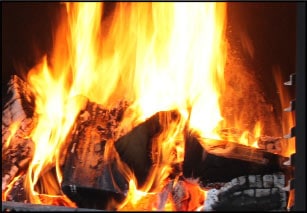 The key to a smoke free fire is a nice, hot fire box with large bright flames. It’s all about good combustion, where the wood ignites quickly and burns all at once, instead of smouldering from one end to the other.
The key to a smoke free fire is a nice, hot fire box with large bright flames. It’s all about good combustion, where the wood ignites quickly and burns all at once, instead of smouldering from one end to the other.
It takes a bit of patience to get the right size pieces and add the right amount of wood at the right time. You are aiming to keep hot swirling flames or a deep bed of hot embers in your fire box. Get
prepared before lighting your fire – you’ll need lots more kindling than you think, as well as smaller logs (you will need both to get your fire hot again if it dies down).
It’s a bit of an art, and you’ll need to keep a close eye on your fire, but it will pay off with more heat and less waste.
Burning dry, seasoned wood is the key
Never burn rubbish or treated, painted, wet or green wood. Wet wood still burns, but gives off a lot less heat and a lot more smoke.
Dry, seasoned wood, burns hotter, cuts fuel consumption and reduces smoke emission.
You can buy your wood already dried and seasoned, but you must store it in a sheltered place, and stack it so air can circulate.
You can also dry and season your own wood – split it and store it off the ground where the sun and wind will dry it out. ‘Seasoning’ takes time, so you will need to allow 6 – 18 months depending on the type of wood, and to make sure sap levels are reduced.
How to get a hot fire with little smoke
Get the fire going quickly:
- Open the air control fully.
- Use firelighters and plenty of dry, small kindling pieces.
- Feed with slightly larger pieces of wood, but not too big. Logs should catch fire quickly rather than smoulder.
- Wail until your fire is burning fiercely before turning the air control down.
Keep your fire burning hot and bright:
- Only add logs to your fire when there are bright swirling flames or glowing embers. Add small pieces of wood if it has burnt down very low.
- Open the air control fully and make sure the logs you add are not too big.
- Keep space between the logs and don’t overload your fire. Air needs to be able to circulate.
If your chimney is still smoking:
- Clean the flue/chimney regularly. Once a year at least, and more often if the fire is used daily.
- Check the cowl and bird protection is clean and clear.
- If the flue has been swept recently, check the flue system has been reassembled correctly.
- Check that nearby trees have not grown too tall as to effect the up-draft of the fire.
- Open the air control fully.
- Move the logs around to allow more air to circulate.
- Add smaller pieces of dry wood.
- Check logs are not blocking the burner’s air supply.





